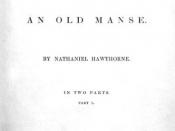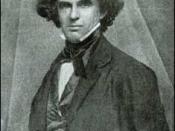Young Goodman Brown After reading Nathaniel Hawthorne's "Young Goodman Brown," I was appalled. I developed an immediate distaste for the story. One might question then, why did I choose it to critically analyze? And my answer to that is simply because I kept wondering why it had such an effect on me. Furthermore, I was motivated to find out what part of Hawthorne's writing got to me so. Through evaluating the story's strengths and weaknesses, I found that the character sketch of Young Goodman Brown most effectively portrayed his story and message making me feel my distaste.
As the story began, I became familiar with Young Goodman Brown and the journey he was about to go on. I was given little background on him so I was compelled to assume. Being as the story is written in Puritan times, I figured Brown was much like any other Puritan: under constant self-examination to see that he is a sinner and totally unworthy of God's grace. My assumptions were proven right throughout the story.
I started questioning Brown's faith in paragraph 17 where he says that he had gone too far into the woods yet he unconsciously resumes his walking. If he really felt that he was being led into sin, why didn't he turn around and go back to his wife Faith? As the story progressed, the negative Brown became more prominent as he noticed the downbeat aspects of life and evil more than he counted on his faith in the Almighty. His faith began to diminish and whither away just as the twigs and little boughs did at the touch of the elder traveler's fingers in paragraph 38. I believe the dried up twigs and boughs were a symbol of Brown's weakening faith. And eventually, even though Young...


